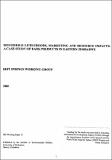| dc.contributor.author | Luckert, M.K. | |
| dc.contributor.author | Gibbs, L. | |
| dc.contributor.author | Grundy, I. | |
| dc.contributor.author | Hauer, G. | |
| dc.contributor.author | Maruzane, D. | |
| dc.contributor.author | Shackleton, S. | |
| dc.contributor.author | Sithole, J. | |
| dc.contributor.author | Nemarundwe, N. | |
| dc.coverage.spatial | Zimbabwe | en_GB |
| dc.date.accessioned | 2014-10-13T14:25:57Z | |
| dc.date.available | 2014-10-13T14:25:57Z | |
| dc.date.issued | 2001 | |
| dc.identifier.citation | Luckert, M.K. (2001) 'Contribution of Baobab Production Activities to Household Livelihoods', In: Household Livelihoods, Marketing And Resource Impacts: A Case Study Of Bark Products In Eastern Zimbabwe, IES Working Paper no. 18. Harare, Mt. Pleasant : IES. | en_GB |
| dc.identifier.uri | https://opendocs.ids.ac.uk/opendocs/handle/20.500.12413/4752 | |
| dc.description | IES Working paper. | en_GB |
| dc.description.abstract | Baobab production activities play a crucial role in contributing to the livelihoods of rural households. In the face of increasing village populations, commercial use of baobab has been steadily increasing to the point where currently, 43% of sampled households participate in baobab production activities. Commercial use of baobab products is especially important to the poorer households arid women. In terms of contributing to household livelihoods, baobab activities are ranked second only to some kinds of agricultural production. Numerical estimates of contribution to livelihoods bear out this result with cash income of approximately Z$5000 per annum received for each participating person, well above the official minimum wage. Opportunity costs of labour make up about four-fifths of this value, leaving one-fifth of the cash income accruing as economic rent. The rent available to households seems to vary widely, as there are households that are well located close to baobab trees, which greatly reduces production costs and increases economic rents captured. The importance of baobabs to livelihoods, combined with the potential ecological importance of these trees in contributing to biodiversity, makes the sustainability of this resource vital. Accordingly, if current use rates are not sustainable (see Romero et al., (in prep) there is scope for investigations into policies and management options that could foster sustainable use. | en_GB |
| dc.language.iso | en | en_GB |
| dc.publisher | Institute of Environmental Studies (IES) ; University of Zimbabwe | en_GB |
| dc.relation.ispartofseries | IES Working Paper Series.;Paper No. 18. | |
| dc.rights.uri | http://creativecommons.org/licenses/by-nc-nd/3.0/ | en_GB |
| dc.subject | Participation | en_GB |
| dc.subject | Rural Development | en_GB |
| dc.subject | Trade | en_GB |
| dc.title | Household Livelihoods, Marketing And Resource Impacts: A Case Study Of Bark Products In Eastern Zimbabwe | en_GB |
| dc.title.alternative | Contribution of Baobab Production Activities to Household Livelihoods. | en_GB |
| dc.type | Series paper (non-IDS) | en_GB |
| dc.rights.holder | University of Zimbabwe | en_GB |


